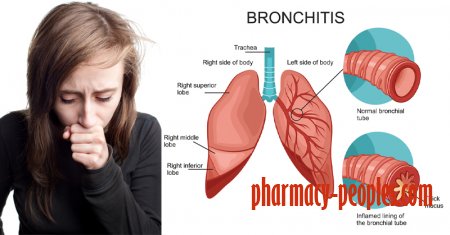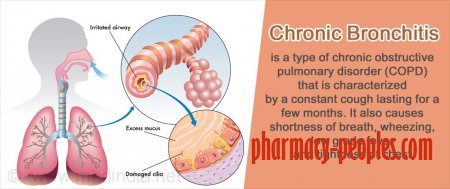CAUSES AND SYMPTOMS OF OBSTRUCTIVE BRONCHITIS
A disease such as obstructive bronchitis, the symptoms is quite specific. Many doctors believe that this type of bronchitis is not a disease. According to these doctors, the disease itself is a simple symptom.
THE ESSENCE OF THE DISEASE
In General, obstructive bronchitis is a disease of an inflammatory nature, affecting the bronchi. The main difference of this kind of bronchitis is the violation of air permeability.
A person can suffer acute or chronic form of the disease. The acute form in most cases appears in childhood. This is due to the fact that children's bodies are more susceptible to attacks of infectious diseases like parainfluenza, adenovirus, influenza, rhinoviruses, etc. However, in children the disease always appears only against the background of other diseases.
In adults also appears most often chronic obstructive bronchitis, symptoms of which are manifested in the form of weakened signs of the acute form. In addition, in adults obstructive bronchitis can progress as a separate disease.
Inflammation in this form of bronchitis is diffuse and mainly affects the small bronchi. In rare cases, can be affected and bronchi of medium size. The symptoms obstructive bronchitis are severe shortness of breath, frequent cough, severe respiratory distress, and rasping breath.
It should be noted that the chronic form of obstructive bronchitis is in the group of COPD diseases. This group includes all diseases and chronic obstructive character, affecting the lungs. Besides, it is worth saying that the disease is associated with bronchial spasms, which often appear in human patients. If the disease for a long time untreated, the disease can progress to bronchial asthma.
THE CAUSES OF OBSTRUCTIVE BRONCHITIS
There are many factors that contribute to the emergence of this kind of bronchitis. Among them are the main factors, which include the following:
- Periodic exposure to infectious respiratory diseases, which include disease group respiratory catarrh, sore throat, flu, disease group acute respiratory infections and other diseases that appear on the background of weakening of the immune system. In addition, the appearance of the disease can contribute to gets in the body human adenoviruses,Mycoplasma and rhinoviruses.
- Other lung diseases that are not associated with a viral infection.
- Factors of production. This includes adverse health conditions in the workplace, living near large factories, etc. it Can be noted that the chronic form of the disease often appears in people who are constantly in contact with various components affecting the respiratory tract. These substances include dust, gas, smoke, chemicals, etc.
- Genetic predisposition. In General, there is no evidence that the bronchitis is transmitted genetically. However, often there were cases when children are sick man, too, was subject to bronchitis.
- Often the disease appears in the background of the impact of air allergens.
- Some refer to the risk factors and Smoking. Tobacco smoke affects the lungs, irritating their mucous membrane.
SYMPTOMS OF THE DISEASE
Doctors diagnose the disease in cases when, in addition to inflammation of the bronchi, in the human body is present with bronchial obstruction. The signs of obstructive bronchitis is very specific and very different from the other varieties of this ailment. So, the main feature of the obstructive form of the disease is severe obstruction of both inhalation and exhalation. This is due to the accumulation of mucus and its subsequent stagnation.
With the development of abundant mucous substance it begins to accumulate and slowly thicken. As a result, begin to form mucous plugs that affects the decrease of vascular permeability. In the future, this affects the difficulty of air traffic that is the cause of wheezing respiration.
The cough begins to worsen in the morning and worried man throughout the day. Sometimes there is an increase in overall body temperature, which leads to fevers. The presence of elevated temperature and fever depends on the catalyst of the disease, trapped in the human respiratory tract. It is noted in the sputum, which is often yellowish. The cough may last for several weeks, maybe for months.
It can be noted that the disease is much harder in children. However, they tolerate it much easier and it is faster. When taking blood not detected any deviations. Slightly can be increased erythrocyte sedimentation rate. When radiographs revealed a swelling of the lungs, increased pulmonary pattern, as well as increased transparency of the lung tissue.
THE SYMPTOMS OF ACUTE OBSTRUCTIVE BRONCHITIS
The acute form of the disease is oftenappears in children under 3 years. The disease has an acute onset and symptoms of toxicity of an infectious nature, as well as bronchial obstruction. Infectious toxicosis is manifested with a total subfebrile body temperature, strong headaches, weakness and dyspeptic disorder. The main role is played by respiratory disorders. There is a dry cough, which eventually becomes wet with phlegm. The cough bothers the patient throughout the day.
Aggravation of the cough begins in the morning, gradually calm down in the evening. At night, however, he does not pass, and it just becomes weaker. In the morning, the cough comes back full force. Moreover, noteworthy and shortness of breath that does not leave man even for a second. There are serious problems with breathing. Thus, when inhalation is marked by a working muscle, which in normal situations should not be used when breathing. Wings of the nasal cavity is greatly inflated, breathing involves the muscles of the shoulder girdle, abdominals and neck.
In addition, the inhalation is marked by a retraction of the pliable areas of the thorax like the jugular fossa, subclavian, and intercostal region of the intermediate territories. When exhaling, clearly audible whistling sounds, as well as a dry wheeze.
In normal situations, acute obstructive bronchitis lasts for ten days or three weeks. In cases when the disease makes itself known two or more times per year diagnosed relapsing form of obstructive bronchitis. If the bronchitis periodically makes itself known within two years or more, noted the chronic form of the disease.
It is worth remembering that the treatment of the acute form of the disease must appoint a physician. In no case do not try to heal disease on their own. When properly conducted treatment there is a high probability that the acute form is rapidly turn into chronic.
SYMPTOMS OF CHRONIC OBSTRUCTIVE BRONCHITIS
With obstructive bronchitis symptoms of chronic forms are constant cough and shortness of breath, which almost never leave the patient. Coughing slightly a bit, highlighting a small amount of sputum, which increases significantly during exacerbation. In addition, during exacerbations of the nature of the sputum changes, it becomes purulent type. The cough is accompanied by a continuous whistling breath. In extremely rare cases, there may be a period of hemoptysis, which appears on the background of arterial hypertension.
In most cases, the appearance ofchronic form of the disease begins with a cough, and then he is joined by shortness of breath. However, there were cases when both symptoms were visible simultaneously.
Shortness of breath can manifest itself in different ways. In some cases, the shortness of breath appears during physical activity, while others present severe respiratory failure.
In General, the severity of dyspnea depends on the degree of the disease.
Exacerbation of disease can occur for different reasons. It can manifest itself during physical activity, after exposure to any allergen air nature, against any infectious diseases, after taking some potent drugs, as a result of decompensation of diabetes, etc.
During exacerbations of the symptoms increase in respiratory failure, fatigue, sweating, myalgia and low-grade fever.
Besides, noted the following signs of obstructive chronic bronchitis, with a longer exhale, severe shortness of breath and wheezing, swelling of the veins of the neck as a result of working her muscles in the respiratory process, change in nail shape. In addition, there could be the appearance of cyanosis in cases of increase of hypoxia.
The treatment of chronic diseases takes a long period. The whole process of getting rid of chronic or alleviate the symptoms should be monitored by your doctor.
- Health / Disease
- 7-12-2018, 22:11
- 2 198
- Pharmatic




